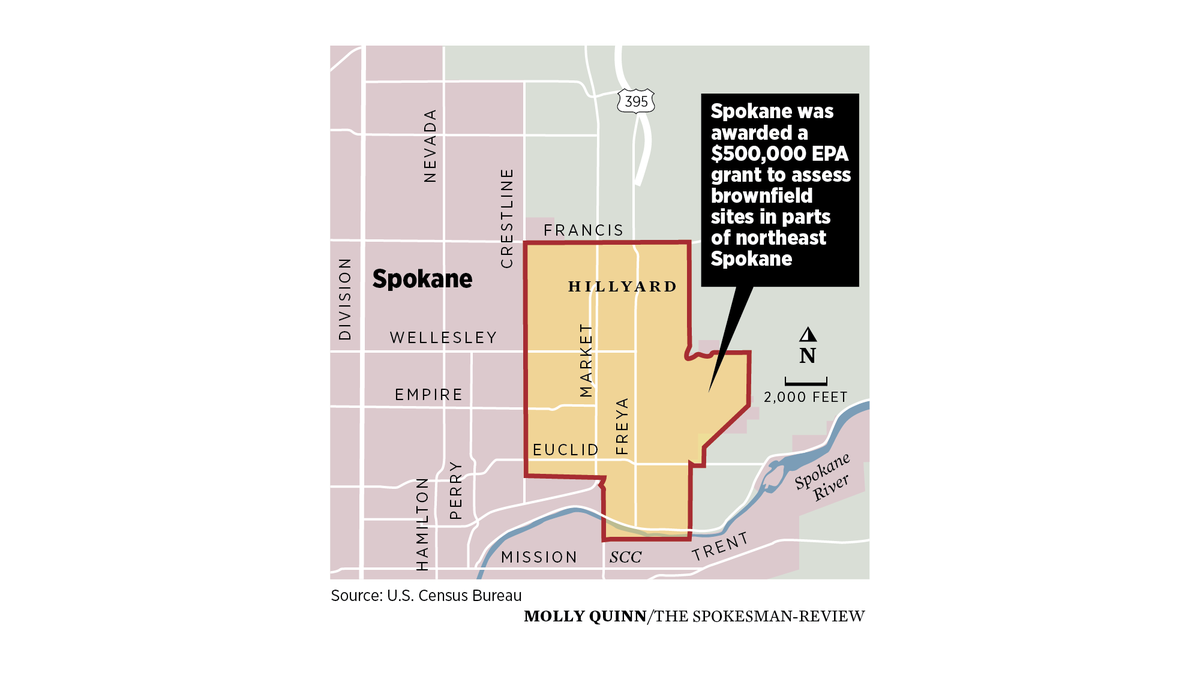Northeast Spokane development eyed as part of brownfield grant to fund environmental assessments, cleanup plans
As the sun sets in downtown Spokane, Washington, a pedestrian walks by the entrance of the City Hall building, Monday, Oct 11, 2021. (COLIN MULVANY/THE SPOKESMAN-REVIEW)Buy a print of this photo
Spokane city officials are hopeful a $500,000 federal grant will help pave the way for more jobs and housing in northeast Spokane.
The city is one of three Washington communities, along with the Port of Tacoma and Olympia, awarded $500,000 brownfield assessment grants from the Environmental Protection Agency. Per the EPA, a brownfield is a site contaminated, or potentially contaminated, by hazardous materials or pollutants.
To clear the way for redeveloping possible northeast Spokane brownfields, the grant will let the city work with public and private property owners on environmental assessments and potential reuse plans.
While the grant will not clean up any sites, the funding “does help eliminate the unknowns for a property that wants to redevelop,” said Teri Stripes, an economic development specialist for the city.
“This is an exciting opportunity to explore the benefits of northeast Spokane and uncover the possibilities for economic and housing growth in one of our most historic neighborhoods,” Mayor Nadine Woodward said in a statement.
The funding is targeted at three low-income census tracts that cover approximately 4 square miles, encompassing parts of the Hillyard, Minnehaha and Bemiss neighborhoods. Census tracts 2, 16 and 144 are collectively home to approximately 12,600 residents, according to the city.
For eligible sites, the grant will cover environmental assessments to determine the property’s past use, where testing may be needed and site samplings for contaminants, Stripes said. The grant also will support cleanup plans to recommend ways to address any contaminants discovered.
Environmental assessments are among the first steps in redeveloping brownfield properties. Riverfront Park and Kendall Yards were each once brownfield sites with histories as former railyards.
In the University District in recent years, the city assisted with site assessments and cleanup and reuse plans for 14 sites , said Public Works spokesperson Kirstin Davis. Notable sites include the new medical education, health sciences and innovation building for Gonzaga and the University of Washington School of Medicine on Spokane Falls Boulevard as well as 206 and 214 W. Riverside Ave. for a mixed-use housing project.
“That is an ideal situation,” Stripes said of the Riverside Avenue project. “That’s what we want to replicate with this new grant up in the northeast area of Spokane.”
With the latest grant, Stripes said this work won’t start until the city is under contract with the EPA, which is expected this fall.
And while the city has some ideal sites in mind, Stripes declined to publicly identify those before determining whether they are eligible.
Still, property owners with sites within the target areas are encouraged to reach out to the Community and Economic Development division to express interest, as Stripes said the city will start building a database.
“If somebody owns a contaminated site, they’re fully responsible for that contamination even if they don’t know it exists,” she said. “They could have purchased this property not knowing it was contaminated, so it’s always a little bit of a risk when somebody starts thinking about what they want to do with their site.”

